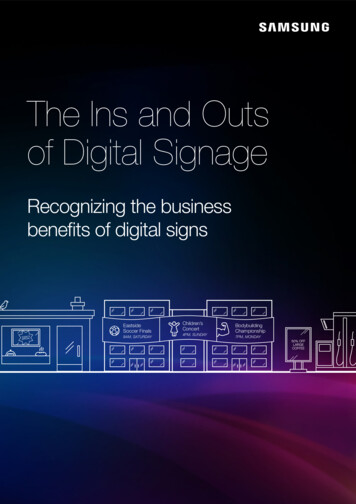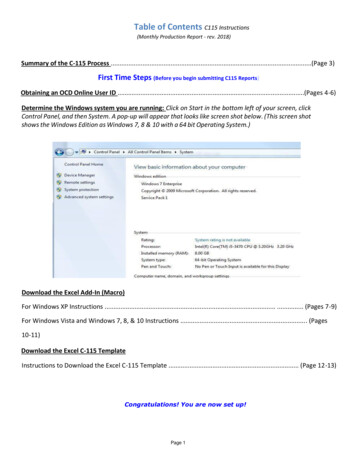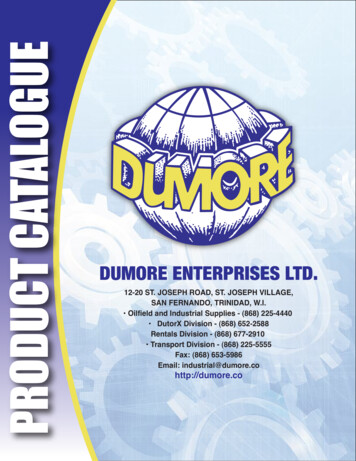
Transcription
The Ins and Outsof Digital SignageRecognizing the businessbenefits of digital signsEastsideSoccer Finals9AM, SATURDAYChildren’sConcert4PM, SUNDAYBodybuildingChampionship7PM, MONDAY
THE INS AND OUTS OF DIGITAL SIGNAGETable of contents21INTRODUCTION2CHAPTER 1: DIGITAL SIGNS, INSIDE AND OUT3CHAPTER 2: OVERCOMING CHALLENGES4CHAPTER 3: SEEING THE BENEFITS5CHAPTER 4: CHOOSING THE RIGHT SOLUTION
THE INS AND OUTS OF DIGITAL SIGNAGEIntroductionPeople rely on screens everywhere they go. They’vecome to expect up-to-the-minute information andinteraction from their favorite businesses, day ornight – whether trying to catch a flight, dodge trafficor just find a good local bagel. Increasingly, smartdigital displays are there to help, with the technologyto offer easy, immediate access to informationthat improves lives: Cancellations and delays.Amber alerts. Updates on the big game, evenfrom the concessions counter. Daily restaurantmenus and details about local ingredients, offeredwhile people wait in line to order. Digital signagecan even help drive social media interactions,further enabling omnichannel retail strategies.Consumers are paying attention. A recentNielsen survey showed that people respond wellto digital signs, both enjoying and rememberingwhat they see. Digital signage in retail has beenshown to increase sales volume by more than 30%,and reduces perceived wait time by as much as35%.1, 2 These kinds of positive responses mayexplain why more than 40% of IT professionalsfrom different industries who use digital signs toldus in a recent Spiceworks survey3 that they thinksmart digital signage solutions are underutilized.At the same time, many of those not using orconsidering the technology said they’re stilllearning about the potential of digital signageand aren’t yet sure how it fits into their particularindustry. How difficult is it to install and maintaindisplay panels and video walls, create and updatecontent that gets real results, and manage theentire implementation? And will the implementationjustify the initial costs of purchasing digital displays?This eBook takes a look at these issues, so you canconsider digital signage in the best possible light.“Consumers are paying attention to the informationpresented to them and acting on it, whether they aredrawn to a location featured on an ad, discussing the adwith friends and family, or attending an advertised event.”Nancy Fletcher, Outdoor Advertising Association of America 23
THE INS AND OUTS OF DIGITAL SIGNAGECHAPTER 1Digital Signs,Inside and Out4
THE INS AND OUTS OF DIGITAL SIGNAGEThe Building Blocksof Digital DisplaysAccording to a Spiceworks survey of more than 150 IT professionals in the U.S., about half of respondents arealready using commercial-grade digital signage, primarily for public information, internal communications and/or marketing promotions. Of those, almost three-quarters are using indoor LCD signs, while 24% use outdoorLCD and 20% reported use direct view LED.3 If these distinctions sound like nit-picking to you, they’re not – howa sign is built determines where it can be used. Here’s a quick overview of some significant differences.24%Food BankFundraiseruse outdoor LCD5/21/167PMIndoor LCDMost indoor flat-panel displays use LCD (liquidcrystal display) technology. The commercial-gradeversion of displays used in commercial TVs, LCDdisplays typically consist of a protective glass layer,an LCD sheet (a liquid sandwiched between twoplates), with a light source behind them. Today’sLCD displays often use LED backlights to light thedisplay. They have brightness measurements upto 700 nits, which is bright and readable in indoorsituations but washes out in full sunlight.5almost3/4are usingindoorLCD signs
THE INS AND OUTS OF DIGITAL SIGNAGEOutdoor LCDOutdoor LCD displays are built to withstand temperature highs and lows and elements such as rain and wind,as well as using special glass and coatings that protect against vandalism and graffiti. They’re designed to bereadable even in bright sunlight, which requires a high brightness level of at least 2,500 nits. These screensmay also feature technology to make them clear and sharp to people wearing polarized sunglasses.High-brightness window displaysThese displays are designed to hang indoors but face outdoors--and still be easily visible and readable in thebright sunlight. They typically generate up to 2,500 nits of brightness, but do not feature the rugged enclosuresof outdoor LCD displays. They are often used in storefront windows, either individually, stacked in totems, orgrouped to make a video wall.Direct view LEDRather than using LEDs as the lighting source (as most LCD displays do), direct view displays use LEDs as thescreen itself. In other words, the LEDs act as the individual pixels of the displayed image. A key measurementhere is pixel pitch, or the distance between individual diodes. Generally, the smaller the pixel pitch, the closer aviewer can stand to the screen and still see a great image. Indoor displays may have a pixel pitch as low as 1.5mm (and therefore a lot more LEDs), while large outdoor displays can have a 6-25 mm pixel pitch or higher. Directview LEDs offer outstanding brightness and energy efficiency, and can bend around curves and wrap corners.They also come in modules that fit together seamlessly, without a visible bezel.EastsideSoccer Finals9AM, SATURDAY6Children’sConcert4PM, SUNDAYBodybuildingChampionship7PM, MONDAY
THE INS AND OUTS OF DIGITAL SIGNAGEConsumer TVs vs.Commercial-GradeDisplaysThe Spiceworks survey indicated there’s a lotof gray area when it comes to digital signage.In fact, a number of respondents even said theywere using consumer HD TVs as “digital signage,”which means these companies are missing outon important features that consumer TVs simplydon’t have.So what are the differences? One is that consumerTVs are rarely on more than 12 hours a day – plus,their warranties will be void if used in commercialenvironments. They’re also built to support lowerspecs, so their components are lower capacity/grade than what businesses need. Digital signs forbusiness use often need to be on 24x7 and to workboth indoors and out, which means these displaysneed to stand up to more wear and tear and beable to handle greater temperature extremes.In response, manufacturers build commercialgrade displays with heavy-duty materials, designthem to withstand heat, severe weather, vandalism7and hacking, and offer extended, more robustwarranties. In addition, digital signs can be usedin both landscape and portrait modes--not justlandscape, like TVs. Another difference betweenconsumer and commercial applications is thatcommercial-grade signage is easier to networkand control. Consumer TVs use IR-based remotecontrols, while commercial displays can becontrolled via RS232 and Ethernet connections.TVs are primarily supported through multipleHDMI connections.Commercial displays offer various inputs includingVGA, Display Port, and Video Control Signal LoopThrough. These connections simplify distributeddigital signage applications.Finally, consumer-grade TVs are designed only toreceive content, while commercial-grade smartsignage platforms can enable content distributionacross a network of displays and can actually helpyou manage it – an important distinction.
THE INS AND OUTS OF DIGITAL SIGNAGECHAPTER 2OvercomingChallenges8
THE INS AND OUTS OF DIGITAL SIGNAGEIT professionals reported the biggest challenges they experience or expect to experience is managing complexity –specifically, handling content management (49%) and updates (42%) – as well as keeping costs down (40%).3Biggest Challenges for IT Pros:49%42%40%Handling contentmanagementHandling contentupdatesKeeping costsdownContentContent poses several challenges for organizations.One, of course, is the challenge of creating it in thefirst place. Then to upload content, IT professionalsmay need to learn how to use a proprietary contentmanagement system, and may also need to makeseasonal, weekly or even daily changes to what’son screen. And they may need to do all those tasksacross multiple display types and locations. Thesetasks can be tackled in-house or contracted to anagency or vendor, who can provide content, contentmanagement, network monitoring and other services.These tasks can also be addressed with an out-of-thebox digital signage solution that comes with contentmanagement software and templates to help youquickly design and schedule simple content.Another option? Digital signage managed services,in which content management and updates are doneby a third party.9MONDAYBreakfastSpecialMONDAYLunchSpecial
THE INS AND OUTS OF DIGITAL SIGNAGECostsThe most basic cost in digital signage is thedisplay hardware itself, which can be expensive,particularly in large installations. Traditional digitalsignage solutions often require separate mediaplayers or computers to host and play content.Complex installations can require additionalmounting hardware, devices and cables – alongwith the expertise to put it all together. Businesseshave to consider the day-to-day costs of powering,maintaining and repairing the signage installation.Given this math, IT pros need solutions that arelong-lasting, energy efficient and easy to deployand maintain, with as few components as possible.Reliability and securityAnother consideration is everything digital signagemust weather, including actual weather such asextreme heat, cold, dust and rain. In addition,digital signage is often located in public places withpotential access by the general public. Outdoordisplays can therefore be tagged and scratched.To keep both equipment and sensitive data safe,IT pros need digital signage solutions with strongbuilt-in protections – not only from the elements,but from deliberate physical damage.10
THE INS AND OUTS OF DIGITAL SIGNAGEThe right digital signagesolutions can helpovercome these challenges.DEPARTURESFLIGHTTOVIAGATE TIMEWeather around the worldARRIVALSFLIGHT FROM VIA GATE TIMEGrab a treatwhile you waitat Annie’s!Across from Gate 2811
THE INS AND OUTS OF DIGITAL SIGNAGECHAPTER 3Seeing the Benefits12
THE INS AND OUTS OF DIGITAL SIGNAGEMany IT professionals surveyed recognized potential benefits of digital signs, including improved internalcommunication, improved ambiance, increased marketing effectiveness, and increased audience engagement.3Finding the digital signage solution that brings you and your organization the same level of satisfaction dependson a number of factors, including cost, reliability, ease of set up and management – as well as, of course, displayquality. Here’s what the right digital signage could do for your business.Out-of-the-box solutionsFor promotional digital content to really work in busyenvironments, including retail and restaurants, itneeds to not only be high quality and engaging,but also easy to create and update on site. Plugand-play commercial solutions offer smaller businesses all the tools they need to do their owndigital signage right out of the box, including TVentertainment and custom content. More advancedsolutions that leverage system-on-chip (SoC) processing integrate the media player into the display,reducing the need to install multiple devices andcables. WiFi-enabled displays allow remote, wireless content updates. These integrated solutionshave a lower TCO and are more easily managed.COMINGSOON13
THE INS AND OUTS OF DIGITAL SIGNAGECustom solutions for more complex applicationsVideo walls with embedded media players candisplay stunning, high-quality visuals, showcaseproducts/services, and help create an open, modernand friendly environment that encourages conversation and consultation. A large, high-brightnessdisplay installation that’s also easy to read throughstore or lobby windows can help draw in sidewalktraffic and prompt people to seek more information.These are examples of complex deployments thatwould likely benefit from support from an experienced digital signage integrator.Large digital signage networks are increasingly builtusing smart signage displays that connect directlyto the cloud over IP, enabling dynamic updates14across multiple locations. Behind the scenes,software solution providers can leverage a software developers kit (SDK) that allows them to tapinto the smart signage display’s built-in system-onchip (SoC) media player. This approach can providesignificant cost savings, as it eliminates the need forexternal media players and simplifies installation.IT professionals can work with their preferred software provider to develop custom applications forthese displays. The potential applications and integrations are virtually limitless, from touch or gestureinteraction to on-the-fly viewer analytics or beaconsto connect with consumers’ mobile devices.
THE INS AND OUTS OF DIGITAL SIGNAGEDirect view LEDs for outdoor useAn integrated digital signage program that includesoutdoor signage can help grab attention, entertainand inform customers. Coordinating outdoor signswith indoor displays can encourage interest in newproducts, cross promotions and loyalty programs.of day or night. They’re also viewable from anyangle, in any light. Commercial-grade componentsprovide IT professionals high uptime and reliability,as well as the ability to quickly update and uploadnew marketing campaigns.Direct view LEDs are bright and easy to see acrossa parking lot in any kind of weather and at any timeAppearing 5 NightsEach Week!GET SEASONTICKETS NOW!Sundayis Ladies’Night!Outdoor signage can help grabattention, entertain and inform customers.15
THE INS AND OUTS OF DIGITAL SIGNAGECHAPTER 4Choosing theRight Solution16
THE INS AND OUTS OF DIGITAL SIGNAGECommercial-grade digital signage offers businesses of every size the tools to elevate andexpand their marketing and sales reach. Leveraging powerful new display technologies andsmart content platforms, IT pros can design creative, customized deployments that transformthe previously mundane landscapes of business – parking lots, waiting areas, even deliverytrucks – into opportunities to connect and engage with customers in more personalized andentertaining ways. In doing so, they get a return on investment that goes beyond higher salesvolume to higher levels of service, both to their customers and their communities.From indoor promotional displays to outdoor direct view LED installations, Samsung canhelp you find the smart digital signage solution that works for your business.SMART Signage Platform (SSP)Allows businesses to work with our partner ecosystem to implement cloudbased digital signage applications. They can be centrally and securely managedacross multiple locations and on a variety of Samsung displays of various sizes,brightnesses and run times.High-brightness LCD DisplaysHelps promote business and engage customers day or night. These solutionscombine bright displays certified to withstand the elements with customizable,integrated solutions to remotely manage and distribute content—and allow easyviewing from any angle, in any light.Direct View LED DisplaysSamsung and its subsidiary Prismview offer a range of LED display modules forboth indoor and outdoor use. These can be configured in any formation andeven curved around structures to deliver bright, dynamic messaging.17
“Savvy companies recognize that partnering withdigital media in new and creative ways can onlyincrease consumer loyalty and their bottom lines.”Digital Signage TodayLEARN MOREAbout SamsungSamsung Electronics Co., Ltd. leads the global market in high-tech electronics manufacturingand digital media. Through innovative, reliable products and services; talented people; aresponsible approach to business and global citizenship; and collaboration with our partnersand customers, Samsung is taking the world in imaginative new directions.Sources1“10 key stats accelerating digital signage adoption,” Digital Signage Today, July �New study highlights effectiveness of digital billboards,” OAAA, August /tabid/327/id/4244/Default.aspx3“Samsung Digital Signage Research Report,”Spiceworks on behalf of Samsung, February 2016.4“Using digital to its potential wins customers over and over again,” Digital Signage Today, Feb -over-again/Twitter: 16SWBlog: insights.samsung.com4
digital signage is often located in public places with potential access by the general public. Outdoor displays can therefore be tagged and scratched. To keep both equipment and sensitive data safe, IT pros need digital signage solutions with strong built-in protections - not only from the elements, but from deliberate physical damage.











